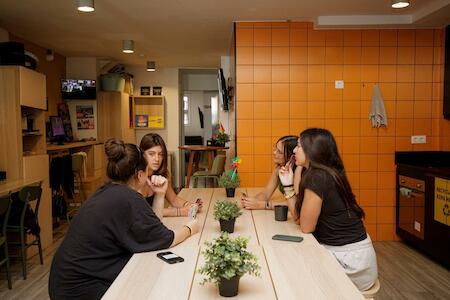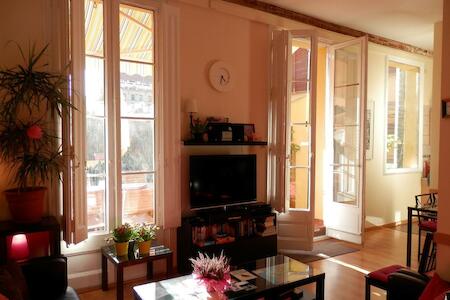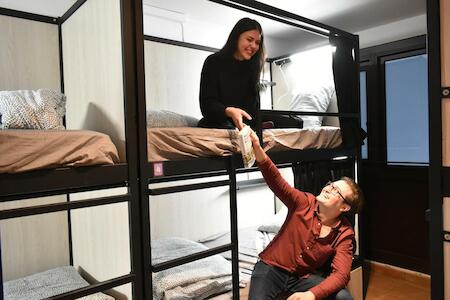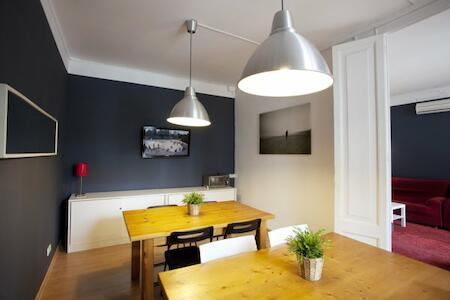This guide is part of our main page where you can compare all hostels in Barcelona. Instantly find the best-rated hostels and real-time prices from Hostelworld and Booking.com. Compare prices side-by-side and save money every time. Learn how we compare prices.
Why Barcelona Is a Great Solo Travel Destination
Traveling solo in Barcelona felt like hanging out with an old friend—it’s comfortable, exciting, and full of surprises. I visited Barcelona on my own and quickly fell in love with how easy it was to explore, meet people, and feel safe.
Below, I’ll share my personal experience and tips for solo backpacking in Barcelona, from why it’s such a great destination to a 2–3 day itinerary, safety nuggets (especially for my fellow female travelers), how to meet people, neighborhood vibes, food recommendations, and a few honest surprises. Let’s dive in!
Top Picks: The Best Hostels in Barcelona
This is not an ad. We help you find the perfect hostel and compare prices from Hostelworld and Booking. You can save up to 23.7%
Hostel Price Statistics & Key Numbers in Barcelona
| Total number of hostels | 90 |
| Typical dorm bed prices in Barcelona | $13 |
| Private room costs in Barcelona | $119 |
| Cheapest hostel in Barcelona | Coroleu House for only $21 |
| Popular Party Hostel in Barcelona | Onefam Paralelo (34 hostels for partying in total) |
| Where to stay in Barcelona on a budget? | Eixample, Gràcia, El Born |
2–3 Day Barcelona Itinerary (Morning to Night)
You can pack a lot into a short trip to Barcelona without feeling rushed. Here’s a suggested 3-day itinerary based on my experience, with each day balancing must-see sights, chill downtime, and opportunities to be social.
Feel free to swap things around—Barcelona is wonderfully flexible!
Day 1: Gothic Quarter & Iconic Sights
Morning: Kick off in the historic Gothic Quarter (Barri Gòtic). I joined a free walking tour that started near Plaça Catalunya, which was a fantastic intro to the city’s history and helped me meet other travelers right away.
We meandered through the labyrinth of cobblestone streets, checking out the Barcelona Cathedral and ancient Roman walls. I loved roaming these alleys solo later, too—every corner reveals a cute café or a street performer. Don’t miss the Pont del Bisbe, the picturesque Gothic bridge that arches over a narrow lane.
Afternoon: Head to La Sagrada Família in the afternoon (make sure you pre-book a ticket online, even a day or two before). Gaudí’s unfinished basilica is absolutely mind-blowing—I spent a good hour inside just staring at the kaleidoscope of stained glass colors.
Even on my own, I didn’t feel lonely; the sheer beauty of the place is great company. Afterward, grab lunch nearby. I found a tiny tapas spot where I stood at the counter chatting (in broken Spanish + hand gestures) with the staff while munching on patatas bravas.
If you still have energy and time, stroll down Passeig de Gràcia to see Gaudí’s other masterpieces like Casa Batlló and Casa Milà (La Pedrera) from the outside. This walk through the elegant Eixample neighborhood is gorgeous and totally doable solo.

Evening: For your first night, dive into Barcelona’s legendary food scene. I suggest heading to the El Born neighborhood, which is lively but a bit less touristy than Las Ramblas.
Wander the Passeig del Born and surrounding streets—they’re filled with hip bars and tapas joints. I treated myself to tapas and cava (Catalan sparkling wine) at a historic bodega. It was easy to strike up conversation with the bartender and other patrons (a solo traveler perk: people often curiously ask where you’re from).
Later, if you’re up for it, join a pub crawl or a hostel-organized night out. Barcelona’s nightlife is electrifying, but as a solo traveler I stuck to group activities like a pub crawl so I had folks to party with. We hopped between bars in the Gothic Quarter—a fun, safe way to experience the night scene together.
Day 2: Gaudí Park, Gràcia & Sunset Views
Morning: Start Day 2 with a little nature and art combo. Park Güell in the Gràcia district is perfect for a morning visit. Get there early to beat the crowds and heat. Park Güell offers vibrant mosaics and sweeping city views—a perfect spot to wander solo.
I entered the park right when it opened and had moments where it felt like I had Gaudí’s whimsical mosaics all to myself. Climb up to the high vantage points for an amazing view of Barcelona’s skyline and the sea beyond. It’s a great place to take selfies or propped-phone tripod shots (pro tip: other solo travelers are usually happy to swap photo-taking favors).
After enjoying Park Güell, wander down into Gràcia, the neighborhood just below the park. Gràcia used to be a separate village and still has a chill, local vibe.
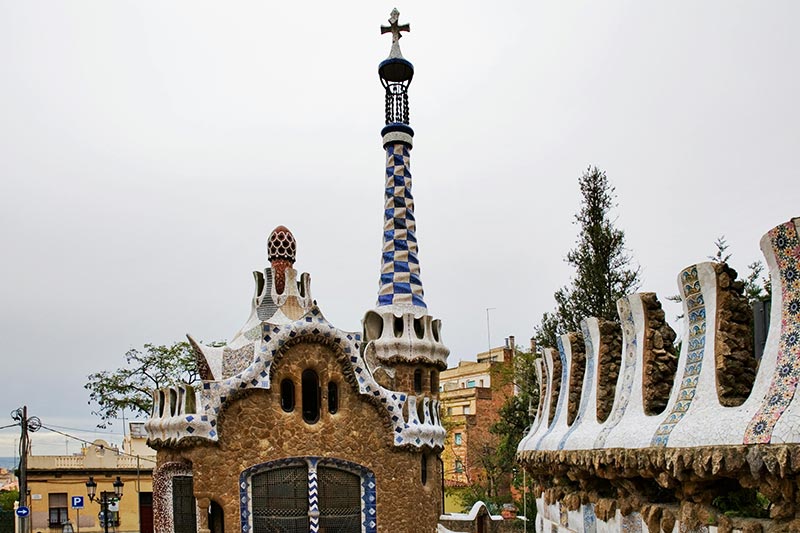
I loved its plaças (squares) like Plaça del Sol—perfect for a late morning coffee. You can sit outside among locals, and no one minds you lingering alone with your journal. Gràcia’s streets are fun to explore, full of boutiques and bakeries. This area is also known for international cuisine if you’re craving something other than Spanish food.
Afternoon: Time to hit the beach or Montjuïc—your choice! On my Day 2, I opted for some beach time. I took the metro down to Barceloneta Beach and spent a relaxing afternoon by the Mediterranean.
Barceloneta is a former fishing village turned beach hotspot, and while it’s popular, I felt safe leaving my stuff close while I took quick dips (I kept an eye on it, of course). You can rent a sunbed or just plop on the sand with a sarong. As a solo traveler, I found it really easy to strike up small talk with fellow beachgoers (or friendly expats selling mojitos). If laying on the beach isn’t your thing, an alternative is Montjuïc Hill on this afternoon.
Montjuïc has a castle, gardens, and museums—you can either hike up (solid exercise but doable) or cheat with a cable car. The views from up there are stunning and it’s a peaceful escape from the city buzz.
Evening: As sunset approaches, a must-do is heading to the Bunkers del Carmel. This is an old anti-aircraft bunker site on a hill, now a favorite lookout point for locals and backpackers. I grabbed a couple of Estrella beers from a convenience store and made my way up with some friends I met at the hostel.
The 360º view at sunset—wow. You see the whole city turn gold. It’s a popular spot, so it felt safe and festive with groups of young people hanging out. I even saw other solo travelers and we exchanged smiles like “Can you believe this view?!” After the sunset session, we all ended up getting cheap empanadas for dinner and then checking out Carrer Blai in the Poble Sec neighborhood.
Carrer Blai is basically tapas/pintxos bar heaven; it’s a street famous for its countless little bars serving bite-size snacks on bread with toothpicks (Basque-style pintxos).
It’s very budget-friendly and super social—hopping from one bar to another with a group is a blast, but even alone you could do a “tapas crawl” and chat with people at each stop. Poble Sec has a local, unpretentious vibe which I really appreciated after the more touristy city center.
Day 3 (Optional): Day Trip or Deeper Exploration
If you have a third day (or more), lucky you! You can either dig deeper into Barcelona or take an awesome day trip. On my third day, I decided to venture outside the city for a bit of nature.
Montserrat is a popular choice—it’s a mountain monastery about an hour from Barcelona, and it’s absolutely breathtaking. I hopped on a regional train to Montserrat in the morning (very easy to navigate solo), then took a cable car up the mountain. The whole day felt like a peaceful retreat—I hiked a little, listened to the boys’ choir in the monastery, and just marveled at the jagged peaks around me.
I even met another solo traveler on the trail and we ended up hiking together for a while. By evening, I was back in Barcelona feeling recharged.
If mountains aren’t your thing, other Day 3 ideas: Picasso Museum in El Born (free on certain afternoons, but get there early), a food tour or cooking class (learn to make paella!), or simply park-hopping.
Barcelona has some lovely parks like Parc de la Ciutadella—I spent an afternoon there people-watching and even boating on the little lake. It was an unexpectedly fun solo activity.
Also, consider exploring neighborhoods you haven’t seen: El Raval with its edgy street art and the MACBA museum (hold your bag tight here though, as pickpockets are known in this area), or Sant Antoni for its famous market and brunch spots. Basically, use Day 3 to catch whatever you missed or to just do nothing and savor the city’s ambiance—you’re on your own time after all.

Safety Tips for Solo Travelers (Especially Female Travelers)
Before arriving in Barcelona, I had heard all the cautionary tales—mainly about pickpockets. It’s true that petty theft is the most common issue here, especially in tourist-heavy zones like Las Ramblas, the metro, or crowded markets.
As a woman traveling alone, I stayed alert but not paranoid. I used a cross-body daypack that locked, kept my hand on my bag in busy areas, and didn’t flash valuables. Honestly, by following basic street smarts, I never had any trouble.
Short and crisp: The Best Hostels in Barcelona
- Sant Jordi Les Corts Hostel
- Sant Jordi Alberg - best for Family-Friendly Hostel
- The Hostel Box Port - best for Solo Traveller
- The Hipstel - best for Couples, Female Solo Traveller, Quiet Rest
- Rambla Catalunya Hostel
In fact, there wasn’t a single moment when I felt unsafe or uneasy, even in big crowds. Barcelona has far less violent crime than many U.S. cities, and I personally felt more comfortable walking around at night there than I do back home.
That said, a few realistic precautions go a long way:
- Watch your stuff: In busy spots (like the metro or La Boqueria market), be mindful of your phone and wallet. Common scams include distractions like someone “spilling” something on you or offering a flower/petition—if that happens, firmly say no and walk away. I met travelers who had no issues at all, and a couple who got pickpocketed because they left their phone in a back pocket. Just be aware of your surroundings.
- Night safety: Barcelona loves to party, and I wanted to experience the nightlife too. I found it safest to go out with a group (like people from my hostel or a tour). In clubs and bars, I kept an eye on my drink and stuck to well-lit, busy streets when walking at night. Popular neighborhoods like Eixample and Gràcia felt generally safe even later at night—I walked back to my hostel in Gràcia at 1 AM and it was quiet but I didn’t feel threatened, as there were still a few people around and streets are well-lit. In contrast, El Raval area can get sketchy late at night (it’s known as one of the rougher areas), so I mostly avoided its darker side streets when I was alone.
- Trust your instincts: This is universal advice, but worth repeating. If a person or situation is giving you bad vibes, it’s okay to remove yourself. I politely declined overly persistent street vendors and if someone started following or catcalling (happened only once, briefly), I immediately walked into a nearby shop where I knew I wasn’t alone. Don’t be afraid to be a bit rude if needed to protect yourself.

For female travelers: I found Barcelona quite liberating. There are plenty of women out and about alone, even late. Of course, I took the same precautions I would anywhere—sticking to public areas, not getting too intoxicated without trusted friends around, and knowing how to reach my accommodation
Also: I screenshot directions before going out, in case my phone runs low on battery and I have to turn of data (which saves a lot of battery!). Even better tip though: I always charge my phone before going out for the night.
If you ever do feel uncomfortable, duck into a cafe or approach a group of tourists or a family; people are generally helpful.
Overall, the city felt safe and welcoming - but again, pickpocketing is an issue.
By the end of the trip, my confidence as a solo traveler had skyrocketed. I even grew a bit attached to always having my bag in front of me—it became second nature and now I do it everywhere!
How to Meet People as a Solo Traveler
Solo in Barcelona definitely doesn’t mean alone. In fact, Barcelona is one of the easiest places to meet fellow travelers and even locals, thanks to its youthful, international atmosphere. Here are some of the ways I connected with people:
1. Hostel Hangouts
I stayed in a social hostel with a common lounge, which was meetup central.
Most hostels in Barcelona organize activities like free walking tours in the day and pub crawls or tapas nights in the evening. I joined a paella cooking class through my hostel and met a bunch of travelers from around the world—by dinner time we were laughing like old friends over the huge pan of paella we made together.
Even if you’re not staying in a hostel, some of these activities are open to the public or you can tag along if you befriend hostel guests.
The key is to hang out in the common areas and say hello. In the traveler community, a simple “Where are you from?” goes a long way. I found other solo backpackers almost everywhere I stayed, so we naturally teamed up for sightseeing or meals.
Still not sure? Pick my Favorite Hostel in Barcelona
#1 Top Hostel in Barcelona: Onefam Paralelo
This is the overall best rated hostel in Onefam Paralelo. The overall rating is 9.7. You cannot go wrong here.
It is your safest bet in case you are not sure which hostel to pick.
The price for a dorm at Onefam Paralelo starts from $19.80.
2. Free Walking Tours:
As mentioned, the free city tours (often tip-based) are fantastic for meeting people. I went on one my first morning and ended up grabbing lunch with two girls from the tour afterward. Same goes for paid tours or experiences—a Gaudí architecture tour or a Spanish cooking class will have other visitors looking to socialize.
The guides are usually super friendly and often facilitate group introductions. By the end, you’ve got a temporary crew to chat with and maybe make plans for later.
3. Meetups and Apps:
Barcelona has a big expat and digital nomad scene, so there are meet-up events for everything—language exchange, meetup.com gatherings, even apps like Couchsurfing Hangouts or Bumble BFF in travel mode. One evening, I went to a language exchange event at a bar in El Raval; it was basically locals and travelers playing games to practice Spanish/English, and it was such a fun, low-pressure way to connect. Don’t be shy about joining these—they are literally made for people who are new in town.
4. Local Nightlife Activities:
If clubbing solo sounds daunting, try something like a flamenco show or a live music bar where you can enjoy entertainment and maybe chat with your seat neighbors. I went to a small flamenco performance and ended up befriending a fellow traveler there. After the show we grabbed tapas nearby.
Also, Barcelona’s tradition of vermut (vermouth) hour on Sundays and afternoon aperitivo means people are out being social in daytime too. It’s common to stand at a bar during weekend midday, sipping a vermouth and nibbling olives—a perfect casual setting to exchange a few words with someone next to you.
More:
Are the locals approachable? In my experience, yes—but you often have to make the first move if you want to break the tourist-local barrier.
Catalans can be a bit reserved compared to the stereotype of Spaniards, but they are polite and helpful. I had friendly small talk with shopkeepers and people at markets. One local gentleman saw me looking puzzled at a train map and asked if I needed help—next thing I knew, we were chatting about Gaudí’s architecture for 10 minutes. Generally, I found it easier to meet other travelers than to deeply befriend locals in just a few days, but the locals I did interact with were kind. If you really want to meet locals, consider joining an interest-based activity (like a yoga class, art workshop, or a dance class) where you’ll meet Barcelonians who share your hobby.
In summary, you might arrive solo, but you could leave Barcelona with a dozen new friends (I certainly collected a stack of Instagram handles and WhatsApp contacts). The city’s social scene and the sheer number of travelers make it almost harder not to meet people! Just be open to saying “yes” to invitations and be fearless about striking up conversations—nine times out of ten, people are happy you did.
Food and Drink: Eating Solo in Barcelona
Let’s be real: one of the best parts of Barcelona (and Spain in general) is the food. As a solo traveler, you might wonder if it’s awkward to enjoy all these tasty experiences alone. I’m happy to report that eating and drinking solo in Barcelona is not only easy but genuinely enjoyable—the city is very solo-diner friendly.
Here are my tips and favorites for foodie adventures on your own:
Tapas Bars: The beauty of tapas culture is that it’s perfectly normal to hop from bar to bar, grabbing small plates. In fact, locals do this all the time, solo or with friends. Many tapas bars have counter seating or high tops where you can stand with your plate.
I often ate at the bar, which naturally leads to conversations with bartenders or other patrons. One classic spot I loved is El Xampanyet (near El Born)—it’s a standing-room-only tapas bar famous for its cava (sparkling wine) and anchovies. I squeezed in by the bar, ordered a few tapas and a glass of cava, and ended up chatting with a group of students who were also there.
The noise and bustle means you never feel out of place by yourself. Pro tip: when in doubt, just ask the bartender for their recommendation—they’ll likely give you a hearty suggestion and a smile.

Markets for Lunch: Barcelona’s markets are a feast for the senses and great for a casual lunch. The famous La Boqueria market is a rainbow of fresh produce and local treats—perfect for a quick, tasty meal.
La Boqueria (off La Rambla) is the most famous; it has stalls where you can grab a fresh fruit juice, a cone of jamón ibérico, or sit at a counter for a hot dish.
I had an amazing solo lunch at El Quim de la Boqueria, one of the market stands—I sat on a stool, ordered squid ink paella and watched the flurry of market activity around me. It didn’t feel weird at all to be alone; lots of people are just focused on their food or chatting with the vendor.
If Boqueria is too packed, try Mercat de Santa Caterina (near El Born) or Mercat de Sant Antoni—both are slightly less touristy but equally delightful, with tapas stalls and locals doing their shopping.
Cafés and Coffee: In the afternoons, especially between sightseeing, I’d duck into cafes to recharge. Barcelona has a growing specialty coffee scene (if you’re a coffee nerd, places like Nomad or Satan’s Coffee Corner are worth checking out). But even the simple neighborhood cafes are nice to sit with a cortado and maybe a pastry. Many have Wi-Fi if you need to catch up online.
I spent a comfy hour at Cosmo Café in Eixample, which doubles as an art gallery, just journaling and enjoying some iced coffee.
Not once did I get the “why are you alone” look—the staff actually struck up a conversation about the sketch I was doing. Also, because Barcelona is used to digital nomads, seeing someone on a laptop or solo with a book is commonplace.
Dining Out Alone: For dinner, if you want a sit-down meal, go for it! The Spanish dining schedule is late—locals eat at 9 pm or later—so if you go earlier (say 7:30 or 8), you might have a quieter restaurant to yourself or with a few tables, which can feel more comfortable if you’re alone.
I had a lovely dinner at La Pepita (a popular tapas restaurant) right when they opened. I chose the bar counter instead of a table, which came with the bonus of watching the chefs at work. The waiter ended up chatting with me about each dish. Remember, in Spain it’s totally normal to dine solo.
You’ll often see people enjoying a meal alone, so join the club. Bring a book or just people-watch between bites—I never felt rushed. And if you’re worried about feeling awkward, honestly the food will steal your attention. When I took my first bite of mel i mató (fresh cheese with honey) at a family-run spot, I literally forgot about everything else around me.
Must-Try Foods: Since you’re solo, you get to be selfish about food choices! Some must-tries: patatas bravas (crispy potatoes with spicy sauce and aioli), pan con tomate (toasted bread rubbed with tomato—so simple, so good), jamón ibérico (cured ham) from a market, local cheeses, seafood paella or fideuà (like paella but with noodles). And of course, tapas of all kinds—I often just asked for a mix or the specialties of the house.
Also, Catalonia has its own special dishes like calçots (grilled green onions, in season late winter) and crema catalana (similar to crème brûlée) for dessert. Don’t be shy about treating yourself!
One night I was craving comfort food and found a tiny hole-in-the-wall making homemade empanadas—I got two, sat in Plaça Reial under the palm trees, and had a picnic dinner. It’s one of my fondest memories, proving fancy isn’t required for a great meal.
Drinks and Nightlife Solo: Enjoying Barcelona’s bar scene alone can be fun if you pick the right spots. I gravitated towards casual bars where you can have a conversation or listen to live music rather than big nightclubs (which are better with friends).
For example, Bar Marsella in Raval (Barcelona’s oldest absinthe bar) was a quirky place where I felt like a time traveler—I ended up chatting with another traveler over the cloudy green absinthe mix.
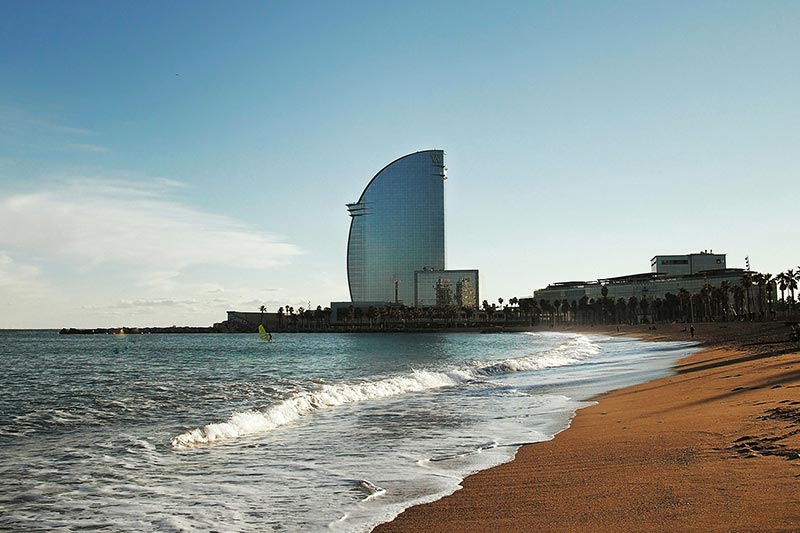
And JazzSí Club was a gem for live jazz—I went alone and found myself tapping my foot alongside strangers-turned-friends. The key is, go to places where the focus is on an activity (music, dancing, watching a game, etc.), which gives you something to do or talk about.
Also, don’t hesitate to join any communal style seating. In Barcelona, it’s not unusual to end up sharing a high table with others if space is tight. It might feel intimidating for a second, but a smile and “hola” can break the ice.
Bottom line: Barcelona will spoil you with food and you don’t need a dinner date to indulge. In fact, being solo meant I could be completely spontaneous—if I saw a crowded churro stand, I just got in line; if a menu del día (fixed lunch menu) special called out to me, I popped in to try it. No deliberating with a group—just pure, delicious freedom.
Looking for a specific district?
Check out hostels near the following landmarks
- Eixample
- El Poblenou
- Arc de Triomf
- Arc de Triomf Metro Station
- Barcelona Nord Coach Station
- Barcelona-El Prat Airport (BCN)
- Barceloneta Beach
- Barceloneta Metro Station
- Beach
- Bogatell Beach
- Camp Nou stadium
- Carrer Sepúlveda – Comte d'Urgell Airport Shuttle Stop
- Casa Batlló
- Casa Milà (La Pedrera)
- Catalunya Metro Station
Final Tips and Surprises
After my solo adventure in Barcelona, I had a few reflections and little surprises—some good, some not-so-good—that are worth sharing:
- You likely won’t feel lonely: I honestly thought I might have bouts of loneliness, especially seeing groups of friends or couples traveling together. Surprise—I was having too much fun to feel lonely! Between exploring all day, meeting people at the hostel, and enjoying the me-time, I rarely even had a chance to dwell on being alone. If anything, I learned to cherish those quiet solo moments (like sitting on the beach at sunrise practically alone, which was magical). Of course, everyone’s experience varies, but Barcelona has a way of keeping you engaged.
- Language isn’t a big barrier: I speak very basic Spanish (and almost no Catalan), but I got by fine. In the very touristy spots, people speak decent English. In more local places, a smile, hola/merci (they speak Catalan in Barcelona, so “merci” is thank you, not French!) and some hand gestures did the trick. I carried Google Translate but rarely used it. Don’t let language worries hold you back. Most Catalans are used to visitors and will try to help. One waiter joked with me in a mix of Spanish and English and made me feel right at home even though I butchered the pronunciation of the dishes.
- The city can feel crowded and touristy: This is one thing I didn’t love at times. In peak season, sites like Park Güell and areas like Las Ramblas are packed. As a solo traveler, that can be overwhelming (and it’s when you need to watch your bag). I found relief by going out early and seeking less-beaten paths in the afternoons. Also, don’t feel like you must do Las Ramblas in depth—honestly, it was my least favorite part of Barcelona. It’s basically a tourist gauntlet with overpriced food. A quick walk-through to see it is enough. Instead, I enjoyed Ramblas’ quieter cousin, Rambla del Poblenou, out near Poblenou neighborhood, which had a more local vibe.
- Siesta time is real (sort of): In the afternoons (around 2–5 pm), a lot of smaller shops and restaurants (especially in non-touristy areas) close for a break. I was a bit surprised how quiet the city could get at siesta time, even though Barcelona keeps a more urban rhythm than a small town in Spain. It’s actually a perfect window to have your own rest—I often used that time to relax at my accommodation, journal in a park, or visit big attractions/museums that stay open. Just don’t panic if you find a restaurant closed at 4 pm; they’ll reopen for dinner around 8.
- Transportation is easy: From the airport to getting around town, it was all solo-traveler friendly. I took the Aerobús from the airport to the city center—quick and safe. Within Barcelona, I mostly walked or used the metro. The metro is straightforward and I always felt fine using it, even at night (trains stop around midnight on weekdays, later on weekends). Buses fill in the gaps, and there are night buses too. I didn’t really need taxis or Uber, but they exist. One tip: keep an eye on your stop; I missed mine once because I was daydreaming! No biggie, I just got off and walked back a bit. Getting lost can lead to unexpected discoveries.
- Embrace the local schedule: I adjusted to later dinners and nightlife, and it actually worked well because it gave me long days to sightsee. Mornings in Barcelona can start slow—things might not open super early—so enjoy a leisurely coffee and pastry to start your day. Late mornings and late evenings are when the city buzzes. I ended up loving the rhythm: siesta chill time and then a second wind at night.
- Budget wise: Barcelona isn’t the cheapest city in Spain, but as a backpacker I managed comfortably. Street food and takeaway empanadas saved me on money and were yummy. Many museums have free entry times (like Sunday afternoons); I took advantage of that at the Picasso Museum. Walking tours for tips, using a refillable water bottle (Barcelona has public drinking fountains), and buying metro passes instead of single tickets are all good moves. I splurged on a couple of big meals and attractions, and saved on others—a balance that worked out. The surprise was that I didn’t spend as much as I expected on nightlife because honestly, some of the most fun was just hanging out in public spaces with newfound friends (which is free!).
Finally, a personal note: Going solo to Barcelona was one of the best decisions I made. I left with not just incredible memories of places, but also a little boost in self-confidence.
Navigating a big city alone proved to me how capable I am—and it was so rewarding that I hardly wanted to leave. If you’re on the fence about solo travel in Barcelona, I say do it. The city will embrace you with open arms (and probably a glass of cava).
It’s the kind of place where you can be as alone or as connected as you want, and either way, you’ll have an unforgettable time.
Happy travels—or as the Catalans say, bon viatge!
Backpacking Barcelona? Here's What You Need to Know
These are the guides I wish I had before visiting. I've been there, had fun, did some minor mistakes, and now I'm passing the best tips on to you. Safe travels!
Our Mission: Help you save money on hostels
We show you all hostels Barcelona has to offer. Filter by district, traveler-type, privacy curtains, and so much more.
All prices come directly from Booking.com, Hostelworld, and other major booking platforms. We do not change any prices. You save on hostels, and we earn a small commission at no extra cost to you. It's a win-win.
Hostelz.com is the world's most comprehensive hostel-focused travel platform. We bring together listings from all the major booking sites to help you easily compare prices, see real guest reviews, and find the best deals—no matter where you're headed. Check out our How It Works page.
Not sure which hostel to pick? Use our Hostel Comparizon Tool to compare your favorite hostels side-by-side before you book.
Let us help you travel smarter and sleep cheaper.

